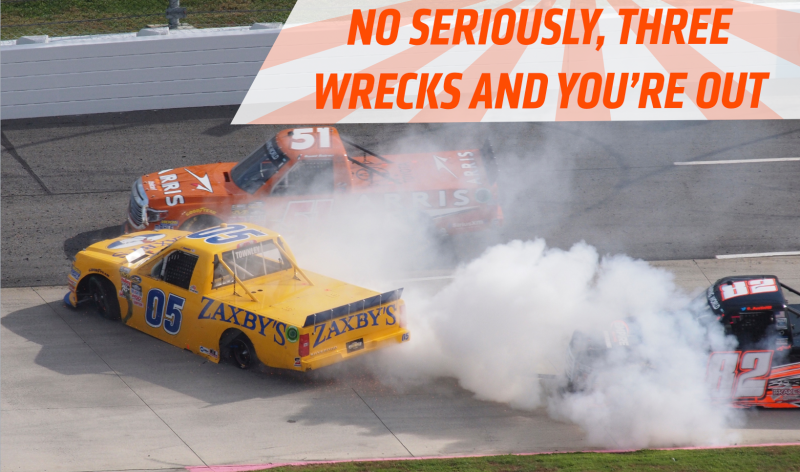
Just over a week ago, NASCAR forgot what it is. A brief moment of confusion led to a lot of not-so-great changes for the series, including an overhaul of the championship formats in both of its top developmental series and a caution clock. A clock. Try to cough that one out. But if NASCAR wants to be like baseball or basketball, there are a few other rules it should try to grab instead.
http://blackflag.jalopnik.com/nascar-just-ma…
http://blackflag.jalopnik.com/nascar-just-ma…
Advertisement
For those who missed the announcement—or tried to forget about it—both the NASCAR Camping World Truck Series and Xfinity Series will now use tweaked versions of the Sprint Cup Series’ Chase format to decide their champions. While NASCAR did do one good thing with Xfinity competition by adding heat races (gasp, something native to motorsports!) to the four eligible Dash 4 Cash events, they essentially turned each green-flag run during a NCWTS race into college-basketball half.
Ding, ding, ding, that’s right—for every 20 minutes of racing outside of the final 10 or 20 laps, there will be a caution.
Sponsored
There are plenty of racing series that do run on a clock, and that’s fine. The races are timed in those cases, so it’s a bit different. Laps and minutes, minutes and laps—they’re overwhelming when combined, and sound too much like forced entertainment and a way to connect with fans of stick-and ball sports.
http://blackflag.jalopnik.com/tony-stewart-p…
http://blackflag.jalopnik.com/tony-stewart-p…
If NASCAR wanted to make a connection with those (fairly disconnected) sports, a clock likely wasn’t the best choice. Just as blocking objects from the goal is a large part of other sports, blocking cars will make a guy named Tony Stewart—the same guy who said he’d wreck his mother to win a championship—come after you in NASCAR.
In that same nature, imagine rotating the running order every caution like volleyball players do in a game. Or if each team got a time out. Or if NASCAR added a countdown clock... welp. But in the midst of its identity crisis, there are a few things NASCAR could benefit from borrowing across all of its series.
Three Strikes (Wrecks) And You’re Out
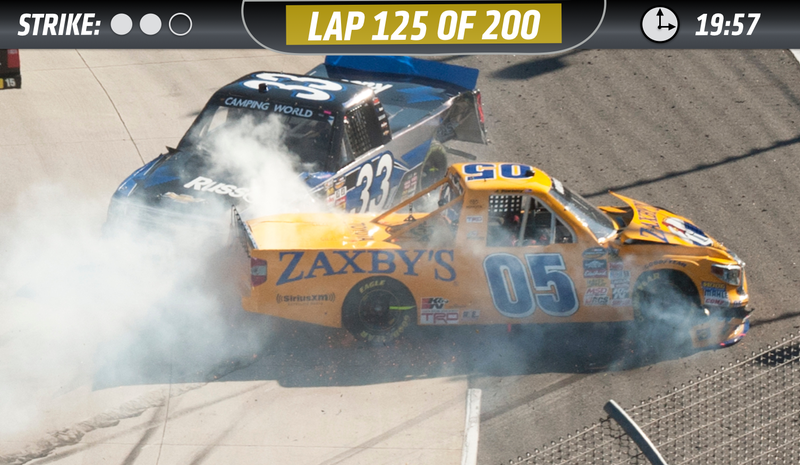
This borrowed rule is for you, John Wes Townley. (Fun fact: If you search “John Wes Townley on AP Images, almost all of the photos are covered in smoke. Not the celebratory-burnout kind, either.)
Baseball had it right when they decided to give each player three chances, and NASCAR could learn from that. Some racing series actually do implement a max number of wrecks that a driver can cause in a single race before officials say “park it,” but not the NCWTS. And with Townley, the series absolutely needs it.
So, in addition to finding a place for a clock on the already-packed graphics package, networks could nestle in three circles under each driver’s name to mark their “strikes” against the field. Three lit circles and you’re out.
The rule is pretty self explanatory, and everyone likes to witness a good walk of shame every now and then. But, unlike baseball, let’s all remember that the goal is not to strike someone out—we’re trying to prevent the wrecks here.
In addition to ramping up the excitement with an exasperated walk from the vehicle and a, “We had a really good [insert sponsor and manufacturer here] today, but just struck right out of luck” interview, you can almost hear Darrell Waltrip in the booth saying, “Boogity, boogity, boogity, yerrrrrr outta here!”
And with this rule in the truck series, we may actually need a caution clock. Townley is the caution clock most times, and he could very easily strike out.
Set Procedures For The All-Star Matchup
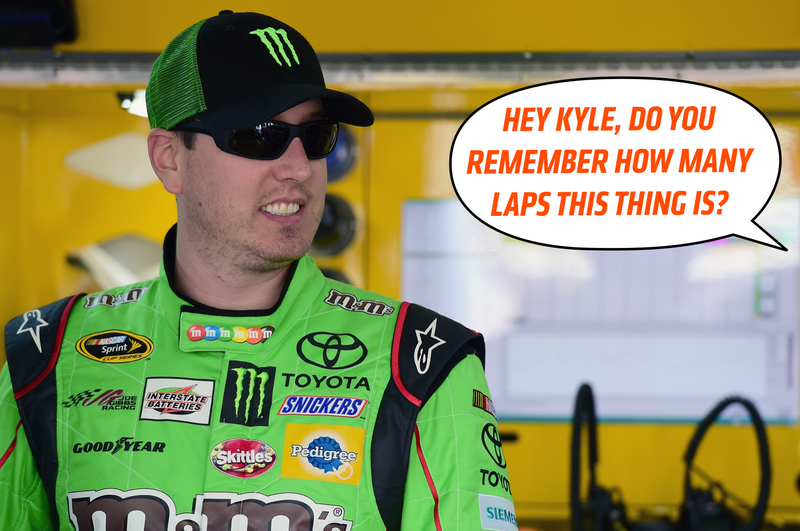
It seems like every single year, the NASCAR Sprint Cup Series All-Star Race heads to the same track—Charlotte Motor Speedway—with a new format.
“This year, we’ll do 20 laps before the first break. Then, we’ll have a 50-lap segment. Then, we’ll make all of the drivers hop out of their cars on pit road, spin in a circle three times with their helmet still on and get back in the car for a 10-lap shootout that includes one lap through the interior road course. Did you catch all of that?”
No, NASCAR. Not really. Can you repeat? Or, can we possibly have a diagram for this? A road map. Give us a road map. And give the drivers co-drivers. Let’s go full-on stage rally with this thing. (Would it really be surprising if they did?) It’s like the playoffs in BASEketball lately.
In order to express why the Sprint Cup Series All-Star Race needs a more consistent format, let’s just take a look at the past six years of the event:
- 2010 and 2011: Four segments adding up to 100 total laps. First segment of 50 laps will require mandatory green-flag pit stop at lap 25, second and third segments each consist of 20 laps. Ten-minute break prior to the final 10-lap segment, in which only green-flag laps will count.
- 2012: Four segments of 20 laps, one segment of 10 laps. Winners of first four segments line up at front of the field for mandatory pit stop before the final segment, which has no restrictions on tire or fuel strategy. (With this format, NASCAR overlooked the fact that segment winners would drop to the back of the field and chil…er, conserve their cars…until the final segment. It was a mess.)
- 2013 and 2014: Four segments of 20 laps, one segment of 10 laps. Average finish in first four segments decides the order in which drivers line up for final, mandatory four-tire pit stop before last 10 laps. Only green flag laps count in final segment.
- 2015: Four segments of 25 laps, one segment of 10 laps. Average finish in first four segments decides the order in which drivers line up for final mandatory four-tire pit stop before last 10 laps. Only green flag laps count in final segment.
If that won’t make your head spin, perhaps nothing will. Who knows what kind of madness 2016 will bring.
When the MLB or NBA get together for an All-Star Game, it’s just the best guys in the league facing off. In a game. Not a game with four innings or two and a half quarters, not a game in which points reset in the last portion to reflect the teams that had the most consistent defense or outfielders in the first segments.
But in NASCAR, everything has to be a bit wonky for it to be an “All-Star” event. And rightfully so, because the best guys in the league compete against each other every week. The race is still in desperate need of consistency, though. Sure, the series isn’t dealing with the most exciting race track—CMS is a 1.5-mile oval, and those just don’t produce the best racing—but there is a fix.
Let’s stop tweaking the formatting and tweak the race cars a bit, so that they’re fit for a run at The Dirt Track at Charlotte. No matter the format, a dirt-track version of the All-Star Race won’t need any changes to be good. Plus, fewer cars in the field will be better considering the track surface and size.
Just don’t call it the “Mudsummer Classic II” or something, because the MLB will have a fit and force NASCAR to change the name of the race.
Staying In Your Own League, Especially When You Are An “All-Star”
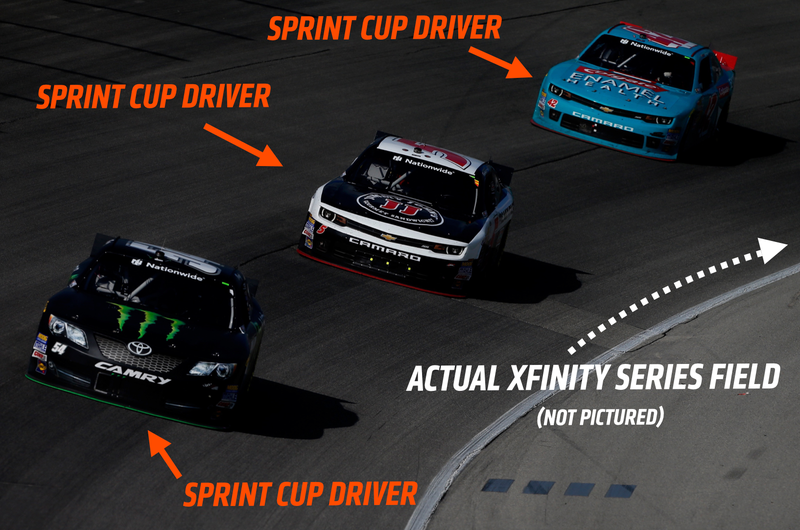
In virtually any sport, athletes graduate from one league and move on up to another. The racing business, on the other hand, lets drivers pretty much do whatever they want if they have the sponsorship and monetary means.
It’s always nice to see an up-and-coming driver defeat one of the big Sprint Cup names, whether in the Xfinity Series or a Late Model race. And as a competitor, racing against the people you eventually hope to emulate is beneficial.
But the reality is that most of the time, the underdog doesn’t triumph over—or even get to compete with—the big dogs. When it comes to Xfinity Series races in particular, the top cars are almost always those of the drivers who aren’t even chasing a driver’s championship in the series. You can’t gain experience if you can’t catch even the people whose footsteps you want to follow in.
There’s no easy fix to the problem, which essentially sucks entertainment from lower-division races 90 percent of the time. Money, owner’s championships, sponsorships and the occasional competition benefits drivers from higher series provide in development races are all factors, and it makes for a tough situation.
NASCAR took a few steps in the right direction, banning any drivers who qualify for the Sprint Cup Chase from competing in the “Championship 4” races of both the NCWTS and Xfinity Series at Homestead-Miami Speedway. But that’s just a bar on one race per series—and doesn’t apply to all Sprint Cup drivers—when the restriction really needs to be put on about half of the season. We’re getting there, at least.
We’re also getting closer and closer to stick-and-ball NASCAR, which is kind of frightening. But so long as the drivers don’t start waving bats from the windows or throwing projectiles (other than “debris” bottles, which won’t be necessary in the NCWTS anymore) on the track, we should survive this round of changes.
Plus, at least all of NASCAR’s top tiers decided to start playing in the rain (on road courses) like most other sports do. That was a good move.
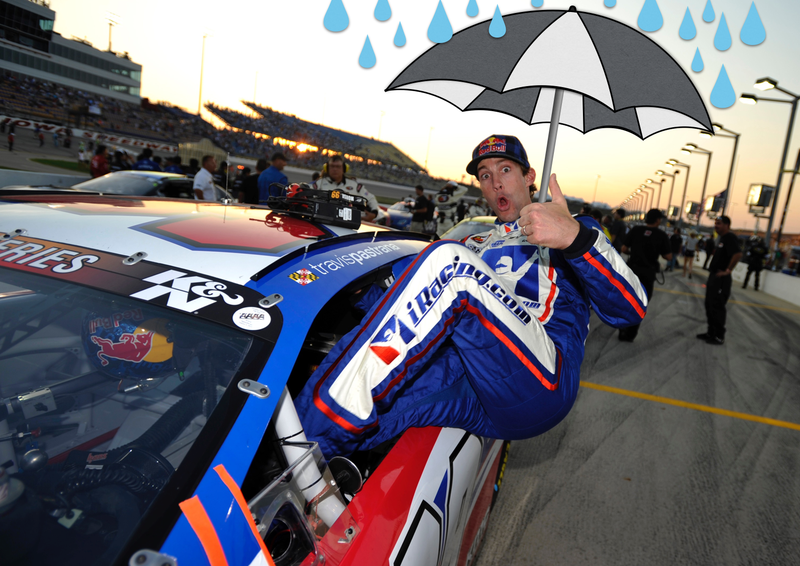
Yes, that is Travis Pastrana and that is a K&N Pro Series car rather than one from a higher division. But do you even know how hard it is to find a photo of one of the top-tier NASCAR guys giving an enthusiastic thumbs up? You’d have better luck brushing your cat’s teeth. Trust me, I would know.
Photo credit: AP Photo/Steve Sheppard, AP Photo/Don Petersen, Jared C. Tilton/Stringer/Getty Images, Sean Gardner/Getty Images,Rainier Ehrhardt/Stringer/Getty Images
Contact the author at alanis.king@jalopnik.com.

